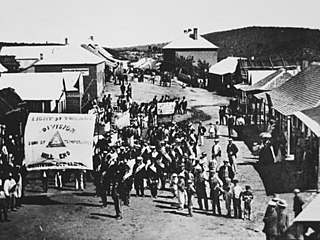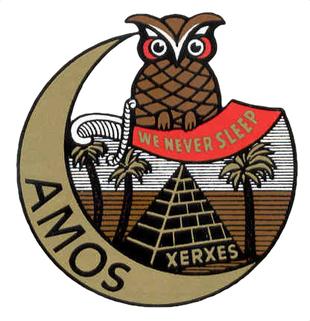Related Research Articles
The Independent Order of Vikings is a Swedish-American fraternal organization promoting Swedish and culture and language. It was founded in Chicago the 1890s and has members throughout the United States.

The Independent Order of Rechabites (IOR), also known as the Sons and Daughters of Rechab, is a fraternal organisation and friendly society founded in England in 1835 as part of the wider temperance movement to promote total abstinence from alcoholic beverages. Always well connected in upper society and involved in financial matters, it gradually transformed into a financial institution which still exists, and still promotes abstinence. The Order has been active in Australia from 1843, promoting temperance and as a benefit society. A branch was established in the United States in 1842, and also flourished for a time. In the United Kingdom, the Order trades under the name of Healthy Investment.

The Knights of Honor, was a fraternal order and secret society in the United States in the late 19th and early 20th century. The Knights were one of the most successful fraternal beneficiary societies of its time.

The International Organisation of Good Templars, whose international body is known as Movendi International, is a fraternal organization which is part of the temperance movement, promoting abstinence from alcohol and other drugs.

The Sons of Temperance was and is a brotherhood of men who promoted the temperance movement and mutual support. The organization was started in New York City in 1842. In the 1840s, it spread quickly across the United States and some of Canada before reaching the UK, Australia and New Zealand.

The Templars of Honor and Temperance, also known as the Tempel Riddare Orden, is a fraternal order that was founded in the United States in 1845 to promote the values of the temperance movement. Founded as the Marshall Temperance Fraternity, the Templars organized as a result of a schism within the older Sons of Temperance, when some felt that the organization did not have an elaborated enough ritual. The new group changed its name several times, first to "Marshall Temple, No. 1, Sons of Honor", then to "Marshall Temple of Honor, No. 1, Sons of Temperance". In 1846, the National Temple of the Templars of Honor and Temperance of the United States was instituted in New York.

Martha McClellan Brown was a lecturer, educator, reformer, newspaper editor, and major leader in the temperance movement in Ohio.
Fraternal Order Orioles is a social and charitable organization that was founded in August 1910. The organization currently consists of about 54 local Nests and affiliated Auxiliaries located in 9 States in the eastern United States.
A fraternal order is a fraternity organised as an order, with traits alluding to religious, chivalric or pseudo-chivalric orders, guilds, or secret societies. Contemporary fraternal orders typically have secular purposes, including social, cultural and mutually beneficial or charitable aims. Many friendly societies, benefit societies and mutual organisations take the form of a fraternal order.

In the United States, the temperance movement, which sought to curb the consumption of alcohol, had a large influence on American politics and American society in the nineteenth and twentieth centuries, culminating in the prohibition of alcohol, through the Eighteenth Amendment to the United States Constitution, from 1920 to 1933. Today, there are organizations that continue to promote the cause of temperance.

The temperance movement in New Zealand originated as a social movement in the late-19th century. In general, the temperance movement aims at curbing the consumption of alcohol. Although it met with local success, it narrowly failed to impose national prohibition on a number of occasions in the early-20th century. Temperance organisations remain active in New Zealand today.
The Knights and Ladies of Honor was a highly successful and popular American fraternal benefit organization in the late 19th and early twentieth century. It is perhaps the first major fraternal benefit organization to adopt the idea of diversity allowing non-white persons and racial groups to be recognized and establish lodges.

Grand United Order of True Reformers was an African-American fraternal organization founded in 1873 in Alabama and Kentucky. Originally managed by deputies of the all-white, pro-temperance organization, the Independent Order of Good Templars, the Grand Fountain of the United Order of True Reformers, or the True Reformers, was re-organized c. 1875 by William Washington Browne in Richmond, Virginia. This organization existed as a business and a mutual-aid society during the era of Jim Crow segregation laws, and it supported the growing African-American middle class through economic opportunities and education, before its closure in 1934.

The Ancient Mystic Order of Samaritans (AMOS) is an unofficial appendant body of all Odd Fellows It is recognized as the "playground for Odd Fellowship" and is known for engaging in public and private hijinks and spectacle, all in the name of good, clean fun. AMOS is open to male Odd Fellows in good standing over the age of 18 but has a close relationship with Ladies of the Orient ("LOTO"), which is only open to women. The two organizations typically meet at the same time and share in social events with each other. Like many other primarily social appendant bodies to fraternal organizations, the rituals and initiations of AMOS have a Middle-Eastern theme and the official regalia is a fez.
The Golden Age of Fraternalism is a term referring to a period when membership in the fraternal societies in the United States grew at a very rapid pace in the latter third of the 19th century and continuing into the first part of the 20th. At its peak, it was suggested that as much as 40% of the adult male population held membership in at least one fraternal order.

Jessie Forsyth was a British-American temperance advocate. She joined the International Organisation of Good Templars (IOGT) in London in 1872, relocated to New England for decades, and celebrated her Jubilee while residing in Western Australia. During her 50 years membership, Forsyth filled many important offices, including 15 years as International Superintendent of Juvenile Templars, in the course of which she visited jurisdictions in Great Britain, the United States and Canada and many parts of continental Europe. She edited the International Good Templar Magazine for eight years and, at different times, did the editorial work on seven other temperance publications, in addition to being a contributor of short stories and poems to newspapers and magazines. She made addresses in various countries before large audiences, including one in the Royal Opera House, Stockholm, and did much secretarial work. The last years of her life were chiefly devoted to work for the WCTU until she was compelled to resign active service on account of ill health.
References
- 1 2 3 4 5 6 Martin, Scott C. (16 December 2014). The SAGE Encyclopedia of Alcohol: Social, Cultural, and Historical Perspectives. SAGE Publications. ISBN 978-1-4833-7438-3.
- ↑ Stevens p.402
- ↑ Ammerman, Robert T.; Ott, Peggy J.; Tarter, Ralph E. (1999). Prevention and Societal Impact of Drug and Alcohol Abuse. Psychology Press. ISBN 9781135672157.
- ↑ Stevens p.408
- ↑ Stevens p.402
- ↑ Hollie, Donna Tyler. "Grand Fountain of the United Order of True Reformers". Encyclopedia Virginia. Retrieved 2023-03-16.
- ↑ "The Grand Fountain United Order of True Reformers Begins". African American Registry (AAREG). Retrieved 2023-03-16.
- ↑ Stevens p.402
- ↑ Stevens pp.402-3
- ↑ Stevens p.402
- ↑ Stevens p.402
- ↑ Stevens p.402
- ↑ Stevens p.409
- ↑ Preuss p.441. Preuss cites Stevens as well as La France Antimaçonnique Vol. XXVII #28 July 10, 1913 p.334
- ↑ Stevens p.412
- ↑ Preuss p.465. Preuss cites Stevens as well as La France Antimaçonnique Vol. XXVII #28 July 10, 1913 p.334
- ↑ The Fraternal Monitor February 1921 vol. XXXI #7 p.13
- ↑ Stevens pp.408-9
- ↑ Stevens p.412
- ↑ Preuss p.468
- ↑ Stevens p.412
- ↑ Preuss p.467
- ↑ Stevens p.412
- ↑ Preuss pp.467-8
- ↑ Alan Axelrod International Encyclopedia of Secret Societies and Fraternal Orders New York; Facts on File, inc 1997 p.265
- ↑ Pegram, Thomas R. (2011). One Hundred Percent American: The Rebirth and Decline of the Ku Klux Klan in the 1920s. Ivan R. Dee. pp. 119–156. ISBN 9781566639224.
- ↑ Prendergast, Michael L. (1987). "A History of Alcohol Problem Prevention Efforts in the United States". In Holder, Harold D. (ed.). Control Issues in Alcohol Abuse Prevention: Strategies for States and Communities. Greenwich, Connecticut: JAI Press. pp. 25–52. ISBN 9780892325450.
- ↑ Barr, Andrew (1999). Drink: A Social History of America . New York: Carroll & Graf. p. 370. ISBN 9780786705597.
- ↑ New Encyclopedia of Social Reform 1908 p.89